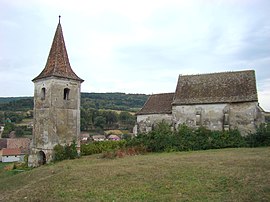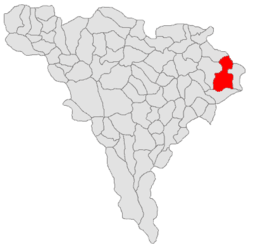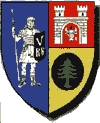Jidvei
Jidvei | |
|---|---|
 Evangelical Lutheran Church in Veseuș | |
 Location in Alba County | |
| Coordinates: 46°13′N 24°06′E / 46.217°N 24.100°E | |
| Country | Romania |
| County | Alba |
| Government | |
| • Mayor (2020–2024) | Alin Trif (PNL) |
| Area | 105.13 km2 (40.59 sq mi) |
| Elevation | 317 m (1,040 ft) |
| Population (2021-12-01)[1] | 5,020 |
| • Density | 48/km2 (120/sq mi) |
| Time zone | EET/EEST (UTC+2/+3) |
| Postal code | 517385 |
| Area code | (+40) 02 58 |
| Vehicle reg. | AB |
| Website | www |
Jidvei (Romanian pronunciation: [ʒidˈvej], Hungarian: Zsidve, German: Seiden) is a commune in Alba County, Transylvania, Romania, located on the river Târnava. Jidvei is located in the north-western part of Romania, in the Transylvanian Plateau. Jidvei was first mentioned in documents in 1309, but traces of human presence go further back in time.[2] The oldest building in the village is the church, which was originally constructed in the Gothic style but was later modified in 1707 in the baroque style. In the 15th century, a fortification wall was raised around the church, of which the gate tower remains.
Jidvei is located in the Târnava wine country, where vineyards have been present since the Iron Age.[3] Winemaking has been an important local industry throughout the history of Jidvei. In the middle age, the doors of the cellars in Jidvei were built to face the road for commercial purposes. Jidvei is currently one of the most important wine producing regions in Romania.
The commune is composed of five villages: Bălcaciu (Bolkatsch; Bolkács), Căpâlna de Jos (Gierelsau; Alsókápolna), Feisa (Füssen; Küküllőfajsz), Jidvei and Veseuș (Michelsdorf; Szásznagyvesszős).
At the 2011 census, Jidvei had a population of 4,617, of which 71.3% were Romanians, 24.8% Roma and 2.6% Hungarians. At the 2021 census, the population of the commune increased to 5,020; of those, 62.65% were Romanians, 29.86% Roma, 1.91% Hungarians, and 1.24% Germans.
| Year | Pop. | ±% |
|---|---|---|
| 1850 | 4,696 | — |
| 1900 | 5,439 | +15.8% |
| 1941 | 6,800 | +25.0% |
| 1977 | 6,720 | −1.2% |
| 1992 | 5,354 | −20.3% |
| 2002 | 5,244 | −2.1% |
| 2011 | 4,617 | −12.0% |
| 2021 | 5,020 | +8.7% |
| Source: INS, Census data | ||
Natives[edit]
- Răzvan Trif (born 1997), footballer
- Veta Biriș (born 1949), folk music singer
References[edit]
- ^ "Populaţia rezidentă după grupa de vârstă, pe județe și municipii, orașe, comune, la 1 decembrie 2021" (XLS). National Institute of Statistics.
- ^ Buza, M.; Stroia, M. (1985). "Ch. 5: Excursii în imprejurimi". Blaj. București: Editura Sport-Turism. p. 83.
- ^ Cotea, V.D.; Barbu, N; Grigorescu, C.C.; Cotea, V.V. (2000). "Ch. A.I.1: Podgoria Târnave". Podgoriile și vinurile României. București: Editura Academiei Române. p. 22.






